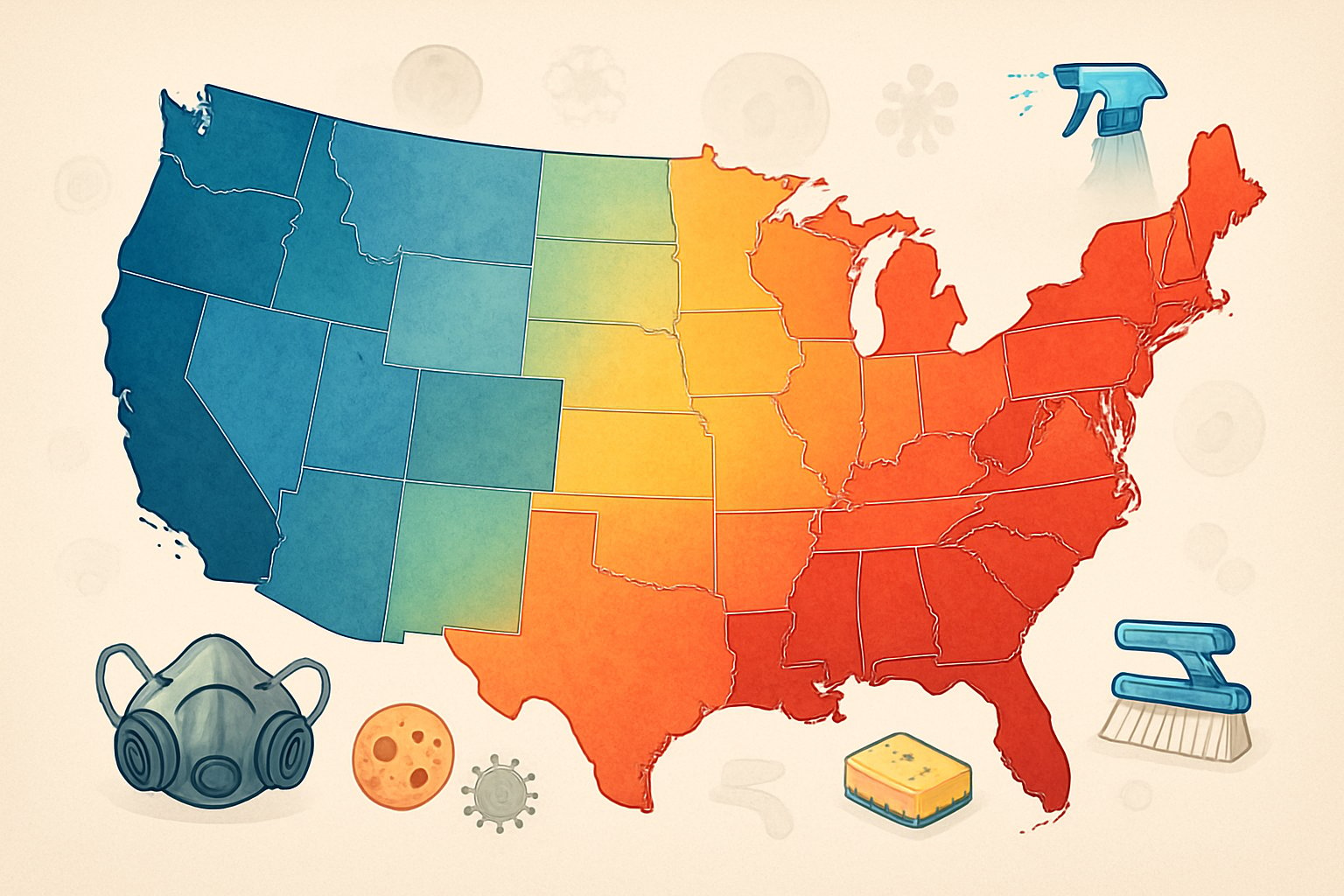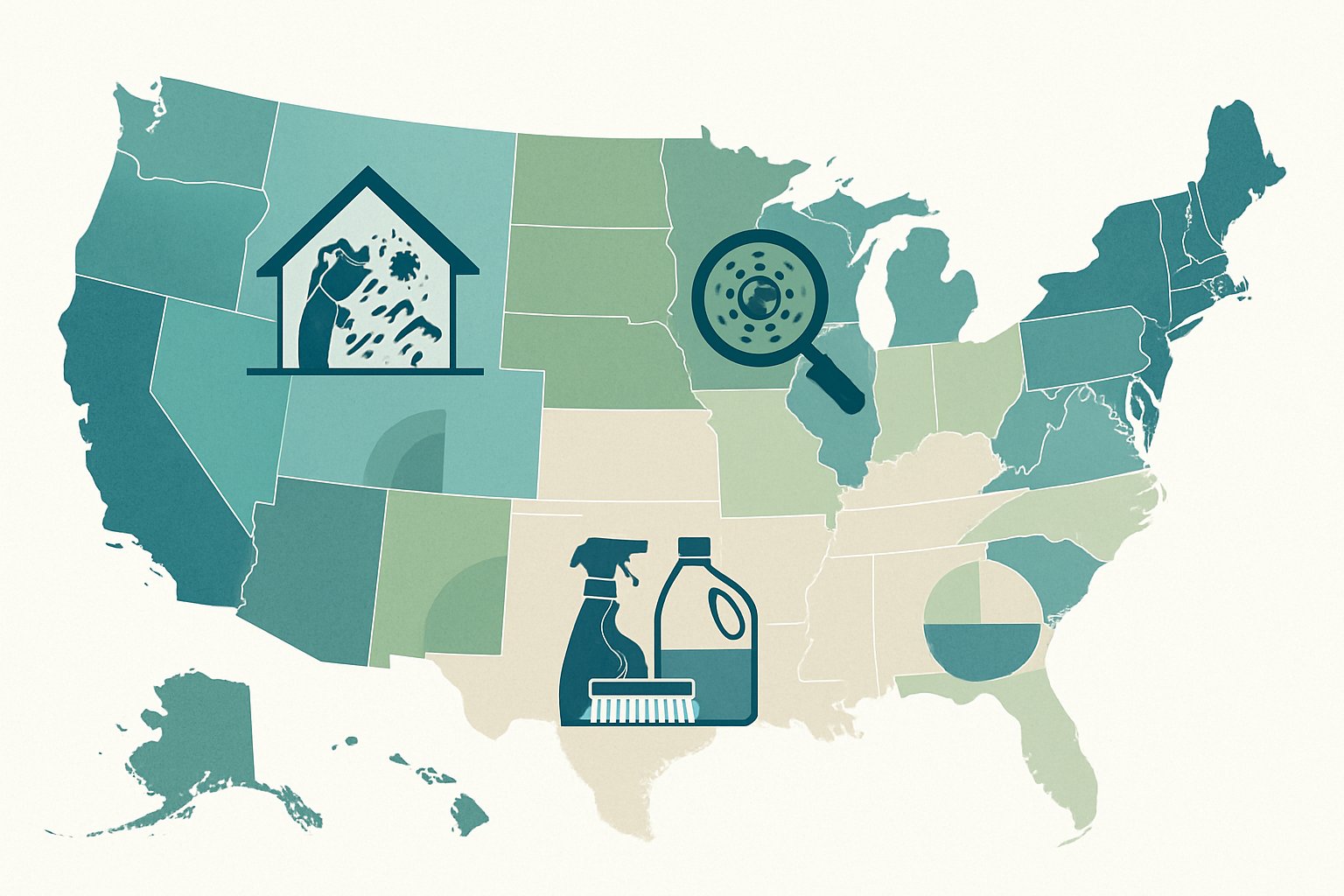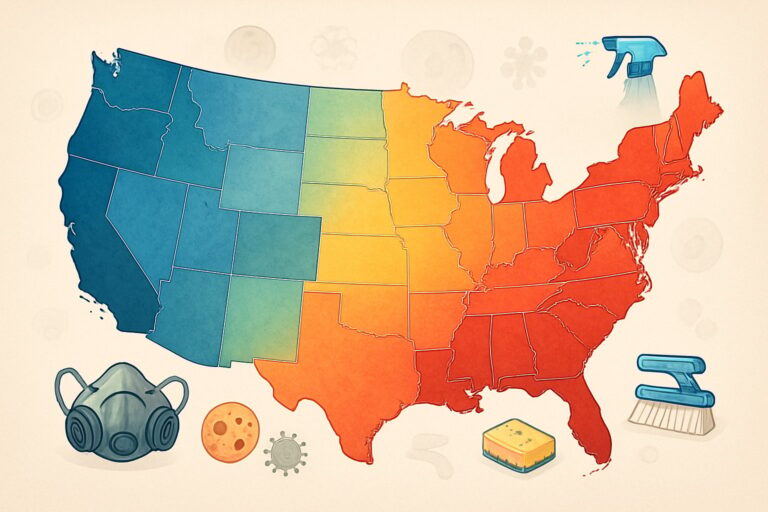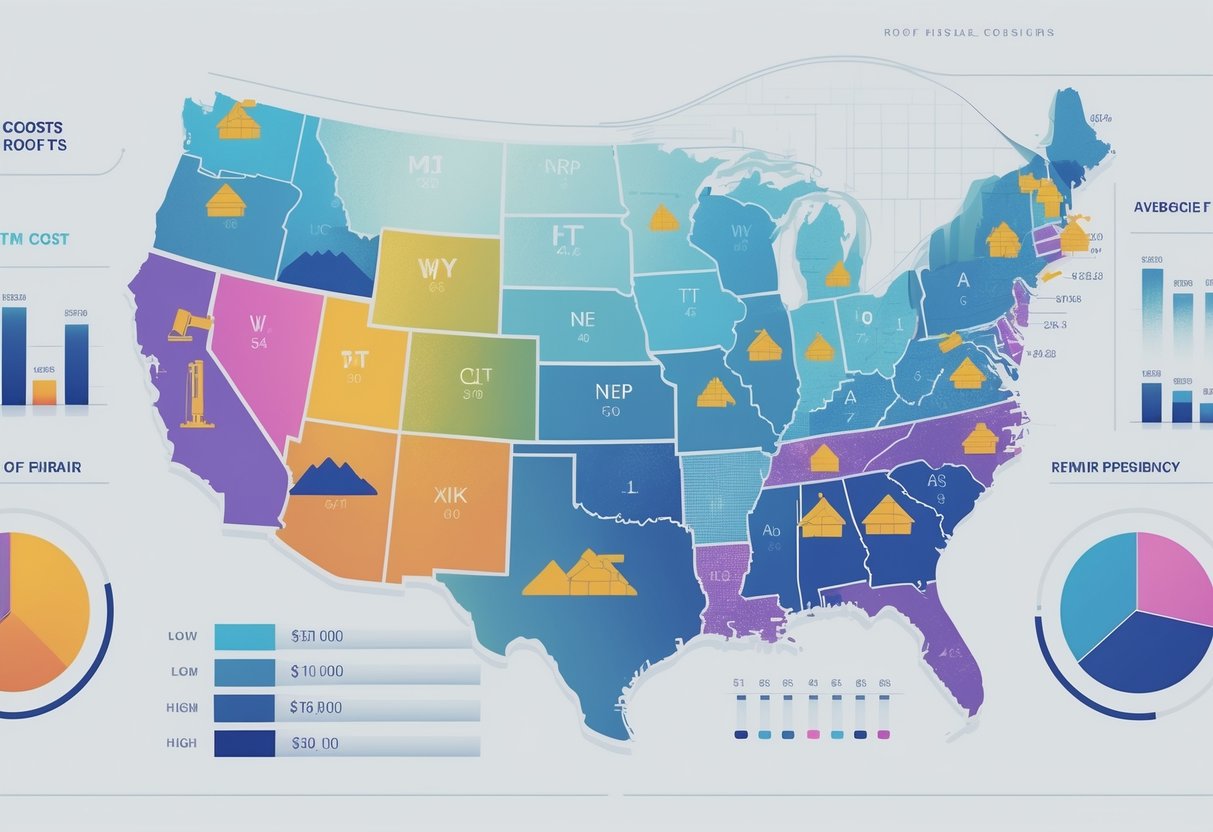Discovering mold in your home is stressful, especially when you start thinking about the removal costs. Mold removal prices swing wildly across the U.S., usually falling somewhere between $500 and $30,000 depending on where you live. Labor rates and local regulations play a big part in the final bill.
Understanding these regional quirks can help you plan ahead—and maybe avoid sticker shock when you start calling for quotes.

Your location really does affect your mold remediation costs. States with a high cost of living usually charge more for these services. If you live somewhere with strict mold regulations, you might need more testing and extra steps.
The type of mold, how much of it there is, and where it’s hiding in your house all play a role in the total cost.
Need a Home Fix – Emergency or Routine?
From leaks and no-heat nights to simple tune-ups, our 24/7 hotline connects you with trusted local pros in minutes.
Let’s break down mold removal costs by region and look at what drives prices up or down. We’ll also cover average costs nationwide, compare different types of companies, and toss in some tips for keeping your mold removal budget under control.
Key Takeaways
- Mold removal costs can be anywhere from $500 to $30,000, depending on the region
- Labor rates, local rules, and your area’s cost of living all affect your final bill
- The spot in your home and the type of mold can double—or even triple—your removal costs
Mold Removal Costs by U.S. Region

Mold removal costs jump around the country because of local labor rates, weather, and demand. Where you live has a real impact on what you’ll pay for professional help.
Northeast Region Mold Removal Pricing
The Northeast tends to have the highest mold removal costs. Most projects here run between $1,500 and $8,000.
New York stands out, with average jobs costing $3,200 to $7,500. High labor and strict rules push prices up fast.
Massachusetts isn’t far behind. Costs usually land between $2,800 and $6,800. In the Boston area, you might pay 20-30% more than the state average.
Connecticut and New Jersey show similar pricing, with standard work ranging from $2,500 to $6,200.
Older homes in this region can be tricky—lots of basements and crawl spaces trap moisture.
The weather doesn’t help either. Cold winters and humid summers make mold a year-round headache, which keeps demand for services high.
Midwest Region Mold Remediation Expenses
In the Midwest, mold removal is usually less expensive than on the coasts. Most folks pay between $1,200 and $5,500.
Illinois averages $2,100 to $5,200, with Chicago prices about 15% higher than the rest of the state.
Ohio often has the lowest prices in the region. Most jobs there cost $1,400 to $4,800.
Michigan and Wisconsin typically fall in the middle, from $1,800 to $5,000.
Missouri and Iowa usually have the best deals, with most projects under $4,500—even for bigger jobs.
Lower labor costs and fewer regulations keep prices down. Plus, newer homes in the Midwest mean less extensive mold work overall.
South Region Mold Removal Cost Trends
Southern states show a wide range of prices, thanks to humidity and local market quirks. Expect to pay $1,300 to $6,000 in most places.
Florida tends to be pricier because of constant humidity. Most projects cost $2,200 to $6,500.
Texas usually has better rates. Jobs run from $1,600 to $5,200, though Houston and Dallas can be higher.
Georgia and North Carolina sit in the middle, about $1,800 to $5,000 for standard work.
Louisiana and coastal spots are expensive, thanks to humidity and hurricane damage.
Year-round growing season means mold is a constant battle in the South. Prevention costs can add up, too.
West Region Mold Remediation Rates
The West has the biggest price swings in the country. Your city or town matters a lot here.
California leads the pack, with projects ranging from $2,500 to $9,000. San Francisco and Los Angeles often go even higher.
Washington and Oregon are also pricey, mostly due to moisture. Most jobs cost $2,200 to $7,200.
Colorado and Arizona offer more reasonable pricing, from $1,700 to $5,500.
Nevada and Utah have some of the lowest costs, thanks to dry climates and less mold overall.
Strict environmental rules in coastal states bump up project costs. Licensed contractors have to follow a lot of extra steps, which adds time and money.
Average Mold Remediation Costs Nationwide
Most homeowners shell out between $1,500 and $6,000 for professional mold removal. The final number depends on the size of the job, the type of mold, and whether you’re dealing with a house or a business property.
National Cost Ranges for Mold Removal
Typical mold remediation projects usually cost $2,500 to $3,500 nationwide. Small problems might only run $500 to $1,500. Big infestations can climb to $6,000, $10,000, or more.
Basement mold removal tends to cost $500 to $2,500, depending on how much mold you’ve got and what’s causing the moisture.
Wall mold remediation runs from $1,000 to $4,000. If the mold spreads behind drywall or insulation, costs go up fast.
Black mold is a whole different beast—it’s pricier to remove because you need special safety gear and containment methods.
Whole-house mold removal is a serious project, often running $10,000 to $30,000. That’s what happens when mold spreads into multiple rooms or your HVAC system.
Typical Costs for Residential vs. Commercial Properties
Residential mold removal usually lands between $1,500 and $9,000. Small jobs (like a bathroom) might be $500 to $1,000. Attic or crawl space jobs can hit $1,500 to $3,500.
Commercial mold remediation costs more because spaces are bigger and the rules are stricter. Expect $2,000 to $15,000 or more for offices and retail spaces.
Commercial jobs need more containment and safety steps. Businesses also want fast completion to avoid downtime.
Insurance coverage isn’t the same for homes and businesses, so check your policy before you start any mold work.
Cost Per Square Foot for Mold Remediation
Most pros charge $10 to $30 per square foot for mold removal. The price depends on the type of mold and how tough it is to reach.
Common mold runs $10 to $15 per square foot. Black mold and other toxic stuff can cost $15 to $30 per square foot.
Crawl spaces and other hard-to-reach spots cost more. Basements are usually easier and cheaper to treat.
| Area Size | Cost Range |
|---|---|
| Small (under 10 sq ft) | $500 – $1,500 |
| Medium (10-100 sq ft) | $1,500 – $3,000 |
| Large (over 100 sq ft) | $3,000 – $6,000+ |
Your total bill covers inspection, containment, removal, and cleanup. Some companies tack on extra charges for repairs or prevention work.
Cost Factors Affecting Mold Removal by Region
Regional mold removal costs depend on three big things: how bad your mold problem is, local labor and material prices, and your home’s size and layout. These factors mix together to create all sorts of price ranges across the U.S.
Severity and Extent of Mold Infestation
The bigger your mold problem, the more you’ll pay—no matter where you live. Tiny spots under 10 square feet are way cheaper than big outbreaks spreading through several rooms.
Mold spores hide behind walls, under floors, and in air ducts. When mold gets into these areas, you’ll need special equipment and more labor, which racks up the cost.
The type of mold matters, too. Black mold needs more safety steps than regular household mold, so expect to pay more for protective gear and extra time.
Mold inspection costs usually run between $300 and $600, but it varies by region. Places with more mold problems might have more inspection companies, which can drive prices down.
Labor and Material Pricing Variations
Labor costs jump a lot from region to region. Big cities like New York or anywhere in California charge higher hourly rates than smaller towns in the Midwest or South.
Mold removal services in pricey cities charge $75 to $150 per hour. Smaller towns might only ask for $40 to $80 per hour. That difference can double your final bill.
Material prices also change based on location. Shipping specialized gear to remote areas costs more. Local building rules also decide what materials contractors have to use.
Some places require special permits for mold removal, which adds $100 to $500 to your total, depending on local rules.
Impact of Home Size and Layout
Your home’s layout affects how hard removal is—and the cost. Single-story homes are easier to treat than multi-level houses with weird layouts.
Basements and crawl spaces cost more because they’re tough to reach. Mold removal services usually charge extra for tight spaces that need special equipment.
Older homes often have more mold-friendly materials like wood and plaster. Newer homes with better ventilation usually have smaller mold problems and lower costs.
Big homes (over 3,000 square feet) can cost $5,000 to $15,000 for a whole-house job. Smaller houses (under 1,500 square feet) typically range from $1,500 to $6,000 for complete removal.
Mold Removal Costs by Location Within the Home
Where you find mold in your house can make a big difference in price. Attic and basement jobs usually run $1,500 to $9,000. Bathrooms are a bit more affordable, at $500 to $1,500.
Attic and Basement Mold Remediation
Attic mold remediation usually runs between $1,500 and $9,000. The cost depends on how big the space is and whether you can actually get in there easily.
Poor ventilation and moisture from a leaky roof or a misbehaving AC unit give mold the green light to spread. If mold gets into your insulation, you’ll have to pull it out and put in new stuff, which definitely adds to the bill.
The cleanup means getting the air moving and sealing things off, so spores don’t sneak into other rooms. Basement mold removal averages $1,500 to $4,000.
Basements stay damp, and the humidity never seems to help. Leaky pipes can turn a small issue into a bigger mess.
Most basement mold covers about 100 to 300 square feet. Crews scrub down the problem spots and use dehumidifiers to dry things out.
Air scrubbers help clear out any stubborn spores still floating around. It’s a process, not just a quick wipe-down.
Bathroom Mold Removal Solutions
Bathroom mold removal usually costs $500 to $1,500. Bad airflow and leaks around showers, tubs, or sinks make it easy for mold to show up.
If the mold’s just on the surface—like tile or glass—you can clean it up with antimicrobial sprays and air scrubbers. That’s the cheaper fix.
When mold hides behind tubs or inside walls, things get pricey. Sometimes you have to rip out drywall or replace other porous materials, which can push costs into the $1,000 to $12,000 range.
Common bathroom mold locations:
- Shower and tub surrounds
- Under sinks and vanities
- Around drains and fixtures
- Ceiling areas above showers
Crawl Space and Wall Mold Treatment
Crawl space mold remediation costs $500 to $2,000, depending on how big the problem is. These areas have similar moisture headaches as basements, but at least they’re smaller.
Crews usually seal off the space, run air scrubbers, and clean with antimicrobial products. Better airflow helps keep mold from coming back.
Wall mold is a whole different beast, with costs from $1,000 up to $12,000. Leaking pipes inside the walls are often to blame.
You can sometimes clean concrete walls with special tools. But drywall and plaster? If mold’s inside, you’ll probably need to rip it out and start fresh.
Always fix the moisture source first—maybe patching pipes or sealing cracks—before you even think about remediation.
HVAC System Mold Removal
HVAC mold removal gets expensive—think $3,000 to $10,000, including air duct cleaning. The specialized gear and labor drive up the price.
Mold in the HVAC spreads spores everywhere, so shut the system off the second you notice a problem. Poor filter maintenance and bad venting let moisture build up, and condensation just feeds the mold.
Cleaning the system means using special equipment to trap airborne spores. Crews seal and clean each duct, and if parts are too far gone, they might need to replace whole sections.
If it’s just simple vent cleaning, you might pay $100 to $500. But once the ducts are contaminated, the price jumps because the job gets way more complicated.
Cost Comparison of Mold Remediation Companies
Mold remediation companies don’t all charge the same. Rates swing based on where you live, what services you need, and how the company runs its business.
Professional services usually range from $500 up to $20,000, depending on what’s actually included in their bundle.
How Pricing Varies Between Local Providers
Local mold removal companies have their own ways of pricing things, which can shake up your final bill. Some go with a flat rate, while others charge by the square foot.
Per-square-foot pricing is usually $10 to $30, depending on your area. Urban companies almost always charge more than rural ones, since their overhead is higher.
Flat-rate pricing varies a lot. Small, local outfits might charge $500 to $1,500 for basic jobs. Big franchises can ask $2,000 to $6,000 for pretty much the same thing.
Labor rates jump around too. Independent contractors often charge $50 to $75 per hour, while established companies might bill $75 to $150 per hour for their techs.
Some companies throw in package deals—inspection, removal, and prevention all bundled together. Those can save you some money compared to hiring each service separately.
What Professionals Include in Their Services
What you get for your money really depends on the company. It’s worth digging into the details before you sign anything.
Basic services usually cover mold removal, surface cleaning, and hauling away contaminated stuff. Most companies include safety gear and containment as part of the deal.
Additional services that might cost extra:
- Air quality testing ($300 to $600)
- HVAC system cleaning ($500 to $2,000)
- Structural repairs ($1,000 to $5,000)
- Preventive treatments ($200 to $800)
Equipment costs are almost always baked into the quote. That means HEPA filters, negative air machines, and special cleaning products are covered.
Some places even offer warranties on their work, usually lasting one to five years. Those guarantees can nudge the price up a bit.
Types of Mold and Their Impact on Cost
The type of mold in your house really changes what you’ll pay. Toxic molds need special handling and gear, so they’re more expensive to deal with.
Common household molds cost less to remove than the scary stuff like black mold.
Cost Differences for Common and Toxic Molds
Common molds like Cladosporium and Penicillium usually cost $500 to $1,500 to get rid of. They love damp spots, but you don’t need extreme safety measures.
Toxic molds are another story. Stachybotrys (black mold) removal can run $2,000 to $6,000 or more. Aspergillus removal often lands between $1,500 and $4,000, depending on the type.
The price difference comes from a few things:
- Testing requirements for toxic species
- Containment procedures to keep spores from spreading
- Disposal methods for contaminated materials
- Professional certification requirements
Black mold removal is the priciest. Workers have to seal off rooms and use negative air systems to keep spores contained.
Specialized Equipment and Safety Measures
Toxic mold removal needs special gear, which bumps up the total cost. Teams use HEPA air filters that can cost $200 to $500 per day to rent.
Safety equipment includes:
- Full-body protective suits
- Respirators with P100 filters
- Containment barriers and plastic sheeting
- Negative air machines
Workers need training and certification to handle toxic molds. Their expertise adds $50 to $100 per hour to labor costs compared to basic mold removal.
Testing before and after cleanup adds $300 to $800. Labs need to confirm that dangerous spores are really gone.
Tips for Managing Mold Remediation Costs
Catching mold early with regular inspections can save you a ton. Keeping moisture in check and making sure your home is well-ventilated helps you dodge big bills down the road.
Inspection and Early Detection Savings
Professional mold inspections run $300 to $600, but they can stop a small problem from turning into a nightmare. Spotting mold early means you can fix it before costs skyrocket.
Check your home every few months for moisture or mold. Pay attention to these spots:
- Basements and crawl spaces
- Bathrooms and kitchens
- Around windows and doors
- HVAC systems and ductwork
- Areas with previous water damage
Small mold patches under 10 square feet usually cost $200 to $500 to fix. Ignore it, and you could be looking at thousands in mold damage later.
Look for water stains, musty smells, or visible spots. These early signs let you jump on the problem before it spreads.
Cost-Effective Mold Prevention Strategies
Prevention is way cheaper than cleanup. Keep your indoor humidity between 30% and 50%—a decent dehumidifier costs $150 to $300.
Essential prevention steps include:
- Fix leaky pipes and faucets right away
- Use exhaust fans when cooking or showering
- Keep gutters clear and direct water away from the house
- Repair roof leaks ASAP
- Make sure all rooms have good airflow
Simple maintenance stops moisture from building up and inviting mold. Spending $50 on a repair now might save you $5,000 later.
Try moisture meters ($20 to $40) in basements and crawl spaces. They’ll warn you before mold has a chance to settle in.
Clean and service your HVAC system every year. Dirty systems spread mold all over and cost $3,000 to $10,000 to fix if things get out of hand.
Frequently Asked Questions
Mold removal costs depend on several factors—regional labor rates, project size, and local rules. Pro jobs usually run $500 to $30,000, while DIY can be way cheaper but riskier.
What factors influence the average cost of mold remediation for different regions?
Labor rates matter most. Areas with a high cost of living charge more for mold remediation.
Local laws and licensing can hike up prices too, since some states require special certifications. Material costs and demand also change by region—remote places might pay more just for shipping.
Humidity plays a big role. Damp climates usually have worse mold problems, which means higher bills.
How does the cost of professional mold removal services vary by square footage?
Most pros charge about $300 per room for basic jobs. Small areas under 100 square feet cost $500 to $1,500.
Medium jobs (100 to 1,000 square feet) run $1,500 to $6,000. Anything over 1,000 square feet can hit $6,000 to $30,000.
The type of space also matters. Basements and crawl spaces are harder to reach, so they cost more.
Materials matter too—drywall is cheaper to fix than wood beams or HVAC systems.
What are the typical expenses involved in DIY mold removal as opposed to hiring a professional service?
DIY supplies cost $50 to $300 for most small jobs. You’ll need protective gear, cleaning sprays, and plastic sheeting.
N95 masks, gloves, and goggles run about $30 to $50. Professionals include labor, equipment, and a guarantee, so the average job costs $2,500 versus $200 for DIY.
DIY is fine for tiny patches under 10 square feet. Anything bigger needs pro gear and know-how.
Could the presence of mold necessitate additional home repairs, and how might this impact the total remediation costs?
Mold can ruin drywall, insulation, and flooring, so you might have to replace them. Water damage repairs add a lot to the total.
You might need plumbing, roof, or foundation work. Structural repairs can double or triple your costs—a $3,000 job could turn into $8,000 with extra fixes.
Cleaning or swapping out HVAC systems adds $500 to $5,000. Contaminated ductwork always needs professional help.
Who is typically responsible for bearing the cost of mold remediation in rental properties?
Landlords usually pay if mold comes from structural issues—think leaky pipes, roof leaks, or bad ventilation.
Tenants might be on the hook if their actions caused the mold, like not cleaning or ignoring water damage. Your lease spells out who handles what, so read it closely.
Some states have specific mold laws for rentals. Most give tenants extra protection and require landlords to act.
What are the legal requirements for mold remediation in residential homes across various states?
Most states don’t actually require a license for residential mold remediation. Still, states like California and New York have their own rules you’ll want to check out.
Professional contractors usually stick to EPA guidelines, no matter what the state laws say. That means things like proper containment and disposal methods are a must.
Some states make you disclose any known mold problems when selling your home. This can impact your property value and what you’re legally supposed to tell buyers.
Local building codes might ask for permits if you’re tackling a big mold remediation job. It’s smart to check with your city or county before you dive into any major work.







Leave a Reply